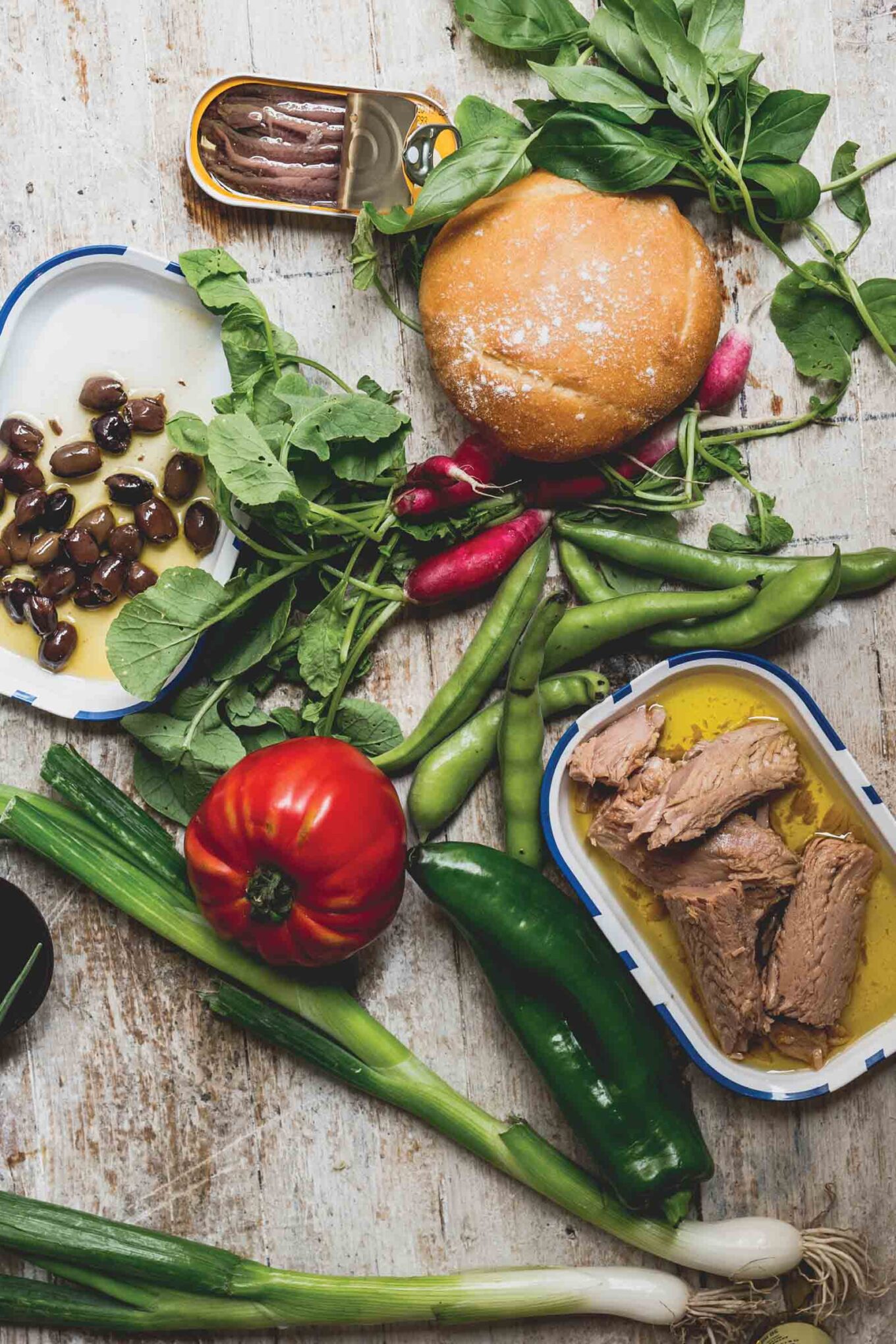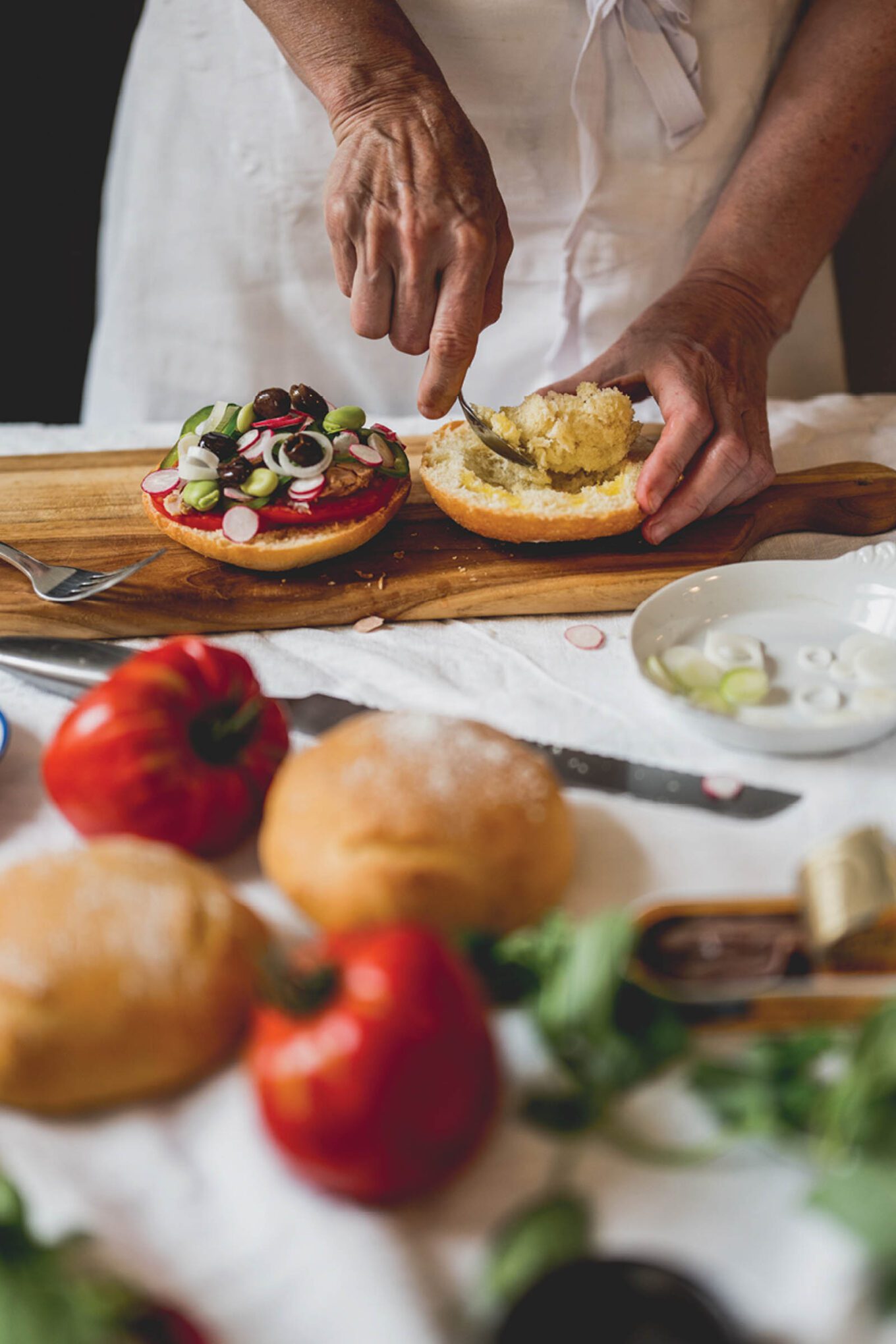
Words by Rosa Jackson. Photos by Jan Hendrik van der Westhuizen.
Pan bagnat, which translates as “bathed bread,” originally made use of stale bread, which was broken into rough chunks and tossed with tomatoes and olive oil. The recipe has evolved over the years, and today it’s a kind of salade Niçoise in a bun that has been doused in olive oil and red wine vinegar. You will find pan bagnat in every bakery in Nice and at roadside kiosks, the best of which have legions of loyal customers. At the Cours Saleya market, you can still see the vendors assembling this sandwich with the ingredients they have on hand to calm midmorning hunger pangs, just as workers have done since the nineteenth century.
Though some bakeries prepare mini pan bagnats using soft brioche dough, pan bagnat normally comes in a crusty bun so gargantuan that it looks unfinishable (though that is, in fact, rarely the case). Some places—including one of my favorites, the bistro La Vieille Maison in Eze Plage—replace the bun with baguette, which, although not traditional, creates a pleasing balance of bread to filling. Another trick for achieving this balance is to scoop out some of the bun’s crumb, making more space for the other ingredients.


This sandwich inspires such strong feelings that since 1991, a local association known as the “Free Commune of Pan Bagnat” has defended it by awarding a label of authenticity to establishments that follow their official recipe. Permitted ingredients include ripe tomatoes, radishes, spring onions, long green peppers, tuna and/or anchovies in oil, hard-boiled eggs, basil, and black olives (no celery or cucumber!). You may remove elements but not add ingredients beyond what is on the list, or the ban bagnat risks becoming “a vulgar vegetable sandwich.”
My complaint with some pan bagnats is that they are heavier on the tuna and egg than on the vegetables; I love this sandwich when it is fresh, crunchy, and colorful. I often leave out the egg, which to me has its place in salade Niçoise but can make the sandwich a little pasty (if you do include it, try cutting the egg into thin wedges, as the locals do). If you can make the sandwiches an hour or two in advance, so much the better.
Order your copy of Niçoise: Market-Inspired Cooking from France’s Sunniest City by Rosa Jackson and savor the flavors of the French Riviera.
Pan bagnat: Summer vegetable sandwich with tuna
Ingredients
- A double recipe of Olive Oil Bread Dough, allowed to rise until doubled in size, or 4 or 6 store-bought crusty buns (6 buns measuring about 5 inches/12 cm across or 4 measuring about 6 inches/15 cm across)
- Flour for the work surface
- 3 large eggs, at room temperature (optional)
- 1 garlic clove, cut in half (optional)
- 6 tablespoons 90 ml extra-virgin olive oil
- Red wine vinegar for sprinkling
- Three 4.5-ounce, 120 g cans tuna in olive oil, drained (or tuna in jars, weighing about 14 ounces/360 g total)
- 2 beefsteak tomatoes, about 1 pound (450 g total), sliced ¼ inch (0.5 cm) thick
- 6 to 8 radishes, thinly sliced
- 2 spring onions, white and pale green parts only, thinly sliced
- 1 celery stalk, thinly sliced (optional)
- 2 mild-tasting long green peppers, such as Anaheim, thinly sliced
- One 2-ounce, 50 g can anchovies in oil
- ¼ cup 45 g pitted Niçoise olives
- 12 large basil leaves
- Sea salt and freshly ground black pepper
Instructions
- Turn the dough out on a lightly floured board, gently press out the air, and divide it into 4 or 6 pieces, depending on the size of sandwich that you would like. Shape each one into a ball and place on a baking sheet lined with parchment paper. Flatten the balls to about 1 inch (2.5 cm) thick, using the palm of your hand. Set aside to rise for about 30 minutes.
- Preheat the oven to 400°F (200°C).
- Make three shallow slashes around the sides of each bun, using a sharp or serrated knife, and bake for about 20 minutes until golden brown. Transfer the buns to a rack to cool completely.
- Bring a small pot of water to a boil. Add the eggs to the boiling water and cook for 8 minutes if you like the yolks slightly creamy, or 10 minutes for hard-boiled eggs. Transfer the eggs to a bowl of ice water to cool, then drain, peel, and cut each one into 6 wedges.
- Split the rolls in half and remove some of the crumb from the top halves, if you like. Gently rub the bottom halves with the cut garlic clove, if using. Drizzle with the olive oil and sprinkle with red wine vinegar to taste.
- Place 2 slices of tomato on the bottom half of each bun. Flake the tuna onto them and top with the sliced vegetables. Finish with the eggs, if using, anchovies, olives, and basil and season with salt and pepper. Press the top half of each bun down so that the bread absorbs some of the juices. Let stand for at least 10 minutes, and up to 2 hours, before serving.
Niçoise: Market-Inspired Cooking from France’s Sunniest City by Rosa Jackson, photos by Jan Hendrik van der Westhuizen (W. W. Norton & Company, 2024).